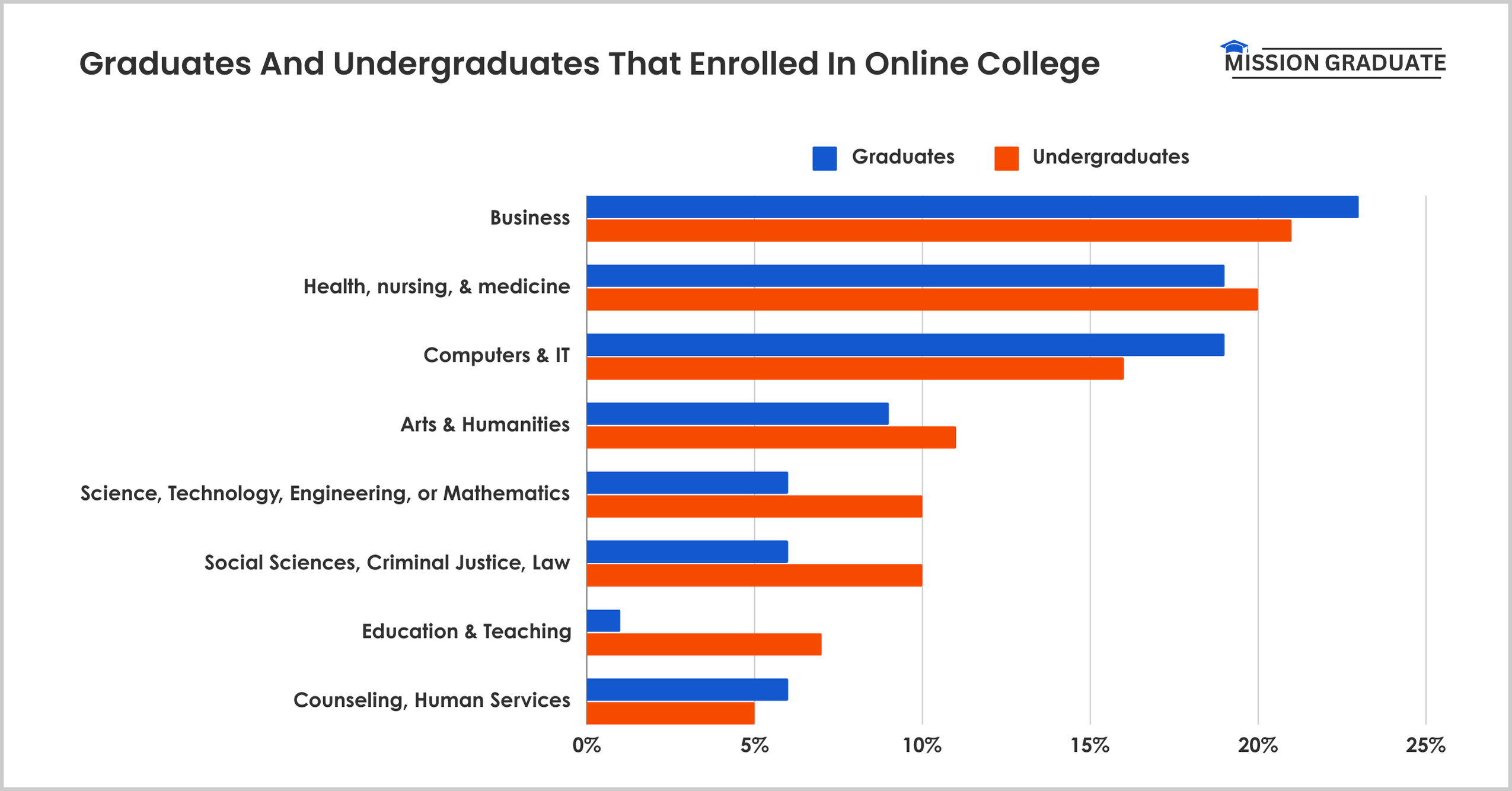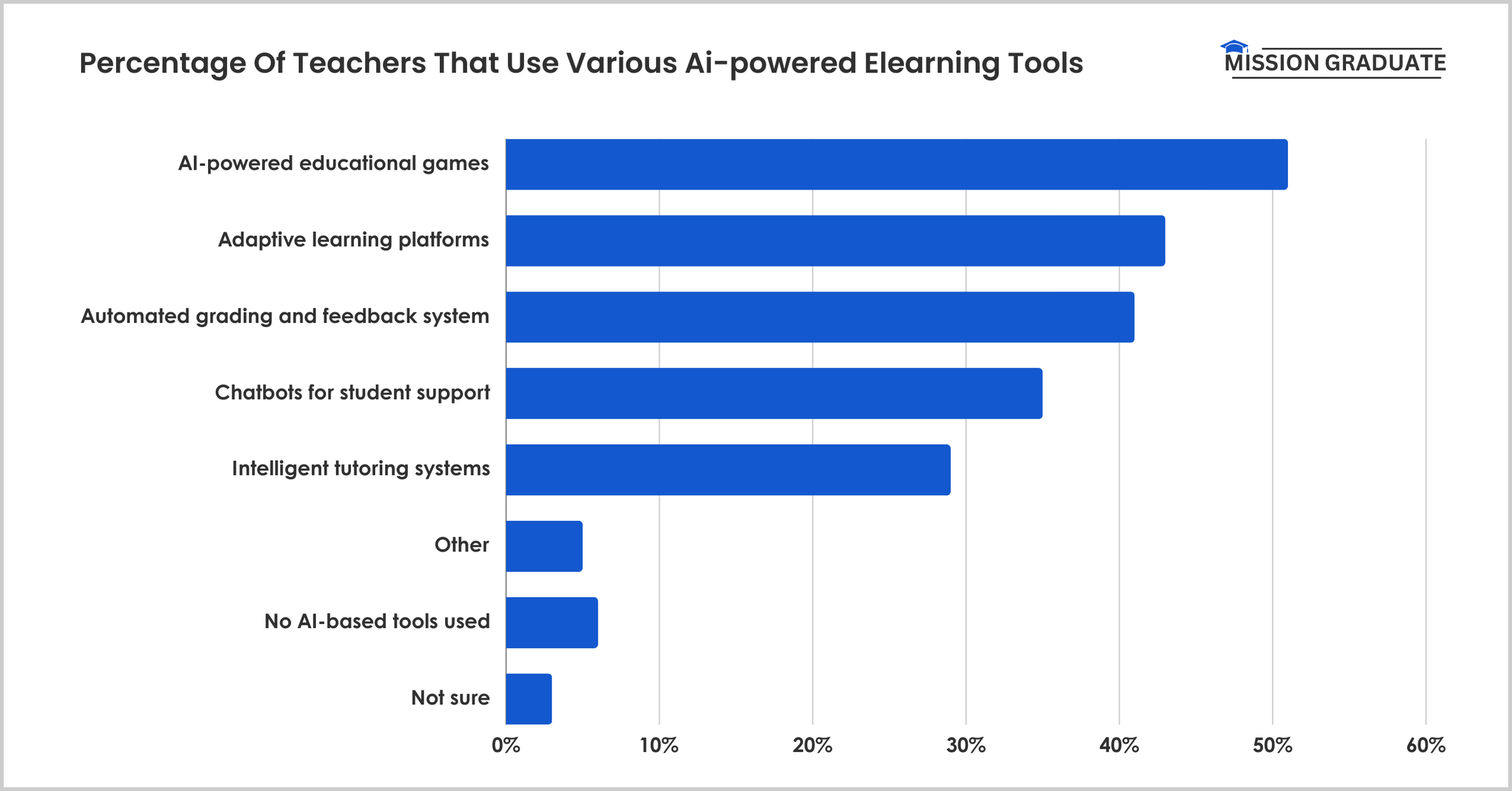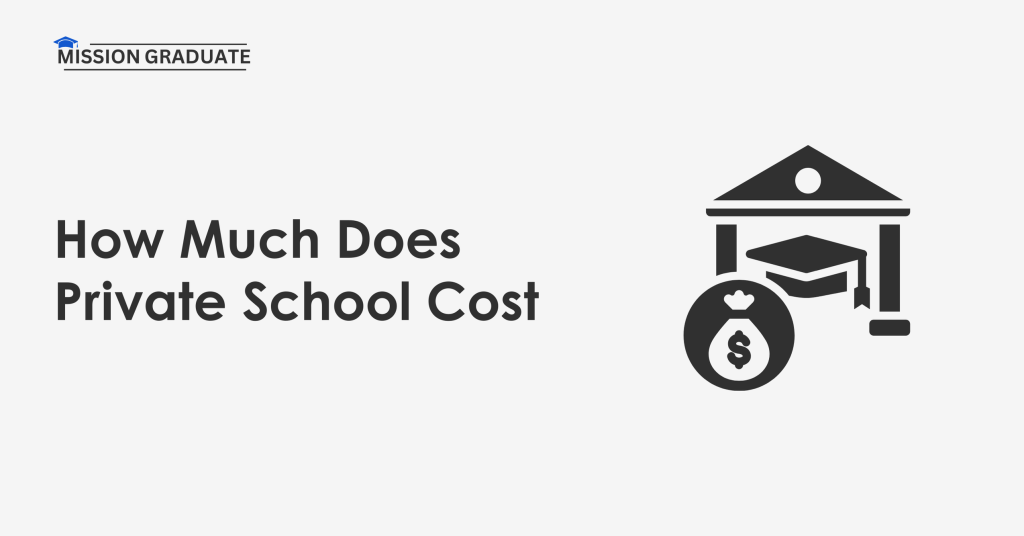The eLearning Industry has grown rapidly and changed the learning landscape worldwide. Today, learners can gain information on the go with the help of online classes, LMS and MOOC platforms, and more.
The eLearning market is projected to grow rapidly from $185.20 billion to $257.70 billion by 2028, reflecting a CAGR of 8.61%.
Let’s explore further details about the eLearning market, Corporate e-learning market, academic e-learning market, mobile learning market, and e-learning market state in different countries with their MOOC stats, LMS stats, adoption of AI in the eLearning market, and more.
Top eLearning Statistics
- The online education market is estimated to reach $185.20 billion.
- The eLearning market in the United States is expected to generate a revenue of $87.51 billion.
- Between 2000 and 2020, the e-learning sector expanded by an amazing 900%.
- 90% of companies and organizations offer some kind of digital learning to their employees.
- 68% of the employees stated that they prefer learning at work.
- 40% of Fortune 500 companies use eLearning.
- The number of online course students is estimated to reach 1 billion by 2027.
- 73% of US students want to continue taking online classes after the pandemic.
Elearning Market Size
The online education market is estimated to reach $185.20 billion.
The online education market worldwide is expected to grow at a CAGR of 8.61% between 2024 and 2028, resulting in a projected market value of $257.70 billion by 2028.
The Online University Education market is anticipated to be the largest among all the eLearning markets. It is forecasted to be valued at $120.7 billion .
Besides, the average revenue per user in the eLearning market is expected to be $0.21k.
The following table displays the revenue and the revenue change of the online learning market over the years.
| Year | Online Education Market | Percentage Change |
|---|---|---|
| 2028* | $257.70 billion | 7.7% |
| 2027* | $239.30 billion | 8.3% |
| 2026* | $220.80 billion | 8.3% |
| 2025* | $203.80 billion | 10.1% |
| 2024* | $185.20 billion | 11.2% |
| 2023 | $166.60 billion | 13.4% |
| 2022 | $146.90 billion | 10.0% |
| 2021 | $133.50 billion | 17.0% |
| 2020 | $114.10 billion | 29.6% |
| 2019 | $88.02 billion | 17.1% |
| 2018 | $75.14 billion | 14.5% |
| 2017 | $65.61 billion | – |
*-Estimated Values
Source: Statista
The eLearning market in the United States is expected to generate a revenue of $87.51 billion.
The market is anticipated to experience a growth of 11.05% between 2024 and 2028. As a result, the eLearning market in the United States is predicted to reach $133.10 billion by 2028.
The Online University Education market is projected to contribute a revenue of $82.30 billion in the United States.
Further, the average revenue per user in the eLearning market in the United States is expected to be $1.45k.
Source: Statista
The eLearning industry grew by 900% between 2000 and 2020.
The eLearning industry is one of the fastest-growing markets in the industry. It allows users to access educational content from anywhere and on any device with an internet connection.
This breaks physical and geographical barriers in the learning process.
Also, the lockdown during the pandemic period fueled the e-learning industry, and its popularity has grown widely since then.
Source: Delvin Peck
The global eLearning market is expected to reach $375 billion by 2026, with AI-driven platforms like OpenAI’s tools contributing significantly to this growth.
OpenAI’s technologies, which have seen widespread adoption, are increasingly being integrated into educational platforms to enhance personalized learning, automate administrative tasks, and improve student engagement.
This synergy between AI and eLearning is reshaping the future of education, making it more accessible, efficient, and tailored to individual needs.
Source: OpenAI Journey
Corporate eLearning Statistics
90% of companies and organizations offer some kind of digital learning to their employees.
eLearning is one of the most cost-effective methods in corporates. Along with reducing the cost of training, e-learning saves employees time, materials, and training room.
As a result, 9 in 10 companies worldwide provide their employees with online training.
Source: LinkedIn
68% of the employees stated that they prefer learning at work.
eLearning helps employees fill their knowledge gaps and upskill themselves with the required skills for their roles. 7 in 10 employees reported that they preferred to learn at work.
At the same time, 58% of the employees said they prefer to learn at their own pace, while 49% prefer to learn when needed.
Source: LinkedIn.
Over 4 in 10 Fortune 500 companies offer regular online learning opportunities to employees.
Over 40% of Fortune 500 companies reported regularly using eLearning platforms to upskill and train their workforce.
IBM reported saving $200 million after shifting some of its workforce training online. The study further revealed that IBM was able to increase the productivity of their employees through online learning, resulting in an ROI of 30%. That means every dollar invested in training resulted in a revenue of $30.
Source: Luisa Zhou, Washington Post
Corporate eLearning requires 40% to 60% less time than traditional learning.
eLearning helps students save up to three-fifths of their time. Employees can learn anywhere on the go when they need it. As a result, their workflow is not affected, and they can learn any skill as required.
Also, employees can return to the concepts they need to revise in e-learning, increasing the chances of retaining the information they learned.
Source: Shift eLearning
Academic eLearning Statistics
The number of students taking online courses is estimated to reach 1 billion by the end of 2027.
With the growing interest of students in e-learning and the packed schedules of students, more students are motivated to enroll in online education programs.
As a result of this growth, nearly 1 billion students are estimated to take their courses online.
Source: Tech Report
73% of the students in the United States wished to continue online classes post-pandemic.
In a recent survey, nearly three-fourths of the students said they would prefer to take some classes online even after the pandemic. However, only 53% of the faculty felt the same about online teaching.
Besides, 68% of the students favored hybrid courses, while 57% of the faculties preferred hybrid courses post-pandemic.
Source: Campus Technology, elearningstats
70% of the students believe that online classes are better than traditional classes.
As online learning helps students retain 25% to 60% of their information, 7 in 10 students prefer online learning over traditional learning.
Meanwhile, 26% of the students claim that they learn better online compared to traditional classroom learning.
Source: University of Potomac
53.3% of the students enrolled in at least one online course in the academic year 2022-23.
Meanwhile, 26.3% of the students enrolled exclusively in online courses in the same year.
Comparatively, 11.2 million college students attended at least one online class in 2021.
That was 60% of the college students in 2021. Besides, 75% of college students in 2020, or 14.2 million students, took at least one online course.
Further, 30% of the college students attended classes exclusively online in 2021.
Source: NCES, Inside Higher Ed
Students enrolled in online courses had 10% to 20% higher dropout rates than traditional classroom environments.
40% of the undergraduate online students dropped out of the program they were enrolled in.
Source: Education Dynamics, files.eric.ed.gov
63% of the high school students used digital learning tools.
At the same time, only 45% of elementary school students and 64% of middle school students used e-learning tools.
Besides, 66% and 10% of grade 6 to 12 students used digital learning tools in computer subjects and English subjects, respectively.
Source: Research.com
75% of United States schools plan to operate on a hybrid or online model.
3 in 4 schools in the United States have plans to shift completely online or run a hybrid model.
74 of the 100 largest school districts in the United States implemented a remote-only instruction model in 2021. Of these, 49% preferred the remote learning model, while 27% preferred the hybrid instruction model.
Source: Delvin Peck
23% of the business graduates and 21% of the business undergraduates completed their college education online.
The business field has the highest number of graduates and undergraduates who completed their studies online.
At the same time, 1 in 2 Health, nursing, & medicine undergraduates and 19% of the graduates studied from online college.

The following table displays the percentage of graduates and undergraduates that enrolled in online college.
| Field of Study | Undergraduates | Graduates |
|---|---|---|
| Business | 21% | 23% |
| Health, nursing, & medicine | 20% | 19% |
| Computers & IT | 16% | 19% |
| Arts & Humanities | 11% | 9% |
| Science, Technology, Engineering, or Mathematics | 10% | 6% |
| Social Sciences, Criminal Justice, Law | 10% | 6% |
| Education & Teaching | 7% | 1% |
| Counseling, Human Services | 5% | 6% |
Source: Statista
Google Classroom is the top learning management system preferred by K-12 students and teachers in the United States.
In academic year 22-23, the majority of K-12 students and teachers in the United States used Google Classroom to manage their online learning process.
At the same time, i-Ready was the most preferred courseware platform.
Here is a table displaying the most used ed-tech solutions by K-12 schools in the United States.
| Solution Purpose | Most Used ed-tech Solution |
|---|---|
| Top learning management system | Google Classroom |
| Top courseware platform | i-Ready |
| Top supplemental platform | Nearpod |
| Top classroom response and assessment tool | Blooket |
| Top study tool | Quizlet |
| Top site/Resource | YouTube |
Source: Statista
Mobile Learning Statistics
The mobile learning market is estimated to be valued at $184.42 billion by 2028.
The mobile learning market size was recorded to be $60.07 billion in 2023 and is anticipated to grow at a CAGR of 24.7% between 2023 and 2028, reaching $184.42 billion.
The major factors promoting the growth of the mobile learning market are the rapid adoption of smartphones and electronic devices in educational institutes, increased investments in information technology, and the growing adoption of bring your own device.
Source: Global News Wire
Mobile Learning improves productivity by at least 43%.
Mobile learners experienced a huge spike in productivity compared to other device users.
Mobile learners usually microlearn and spend 2 to 5 minutes training as feasible. As a result, courses are completed 45% faster than their desktop counterparts.
Further, microlearning has proved to be 17% more effective than other learning methods.
Source: EduMe
46% of the employees use mobile devices to train their employees.
Nearly 1 in 2 businesses train their employees and illustrate the working process through mobile learning.
Mobile learning is taking over traditional learning methods and making it easy to access the required training.
Source: eLearning Industry
eLearning Statistics By Country
China is the second-largest eLearning market worldwide and is estimated to generate $45.06 billion in revenue.
After the United States, China is the largest e-learning market worldwide. The e-learning market revenue in China is anticipated to grow at a CAGR of 0.15% between 2024 and 2028.
As a result, the Chinese e-learning market is projected to be valued at $45.34 billion by the end of 2028.
Source: Statista
The e-learning market in India is estimated to be valued at $6.71 billion.
India is one of the fastest-growing e-learning markets worldwide and is expected to grow at a CAGR of 21.56% between 2024 and 2028.
Hence, the market is projected to reach $14.65 billion by the end of 2025.
The user penetration of the online learning market in India is estimated to be 13.2%. Besides, the number of e-learners in India is expected to reach 287.6 million by 2028.
Source: Statista
The e-learning market in the United Kingdom is forecasted to reach $10.6 billion.
The e-learning market in the United Kingdom is expected to reach $14.60 billion in 2028. The market is expected to grow at a CAGR of 8.33% between 2024 and 2028.
The online learning market in the United Kingdom is expected to generate $0.89k on average per user, and the penetration rate will be at 17.2%.
Source: Statista
The online education market in Thailand is projected to reach $311.60 million.
The revenue of the online learning market in Thailand is expected to be valued at $328.00 million in 2028, growing at a CAGR of 1.29% between 2024 and 2028.
The average revenue per user in the Thailand learning market is estimated to be $46.51, while the user penetration is anticipated to be 9.5%.
By 2028, Thailand is expected to have 8.3 million online learners.
Source: Statista
MOOC Statistics
The MOOC market is estimated to be valued at $22.80 billion.
The market is expected to grow at a CAGR of 39.20% between 2024 and 2029 and is estimated to reach $119.17 billion by 2029.
The major drivers of the MOOC market are growing trends in digitalization, easily accessible Internet, increased penetration of smartphones, and the demand for cost-effective education platforms.
Asia Pacific is expected to be the fastest-growing market in the forecast period of 2024 to 2028, while North America is estimated to be the largest market.
Source: Mordor Intelligence
With 142 million users, Coursera is one of the most popular MOOCs.
Coursera reached 142 million users in 2023, as 24 million users joined the platform that year.
Comparatively, the platform had around 118 million users in 2022, and 26 million users joined that year.
The following table displays the number of Coursera users recorded over the years.
| Year | Number of Coursera Learners |
|---|---|
| 2023 | 142 million |
| 2022 | 118 million |
| 2021 | 92 million |
| 2020 | 71 million |
| 2019 | 44 million |
| 2018 | 35 million |
| 2017 | 28 million |
| 2016 | 21 million |
Source: Coursera, Coursera Impact report
EdX offers over 300 courses with more than 160 partners worldwide.
After Coursera, EdX is one of the most well-known learning platforms, with over 40 million active learners.
Over 110 million total enrollments were recorded on the platform in 2020, and there was a growth of 29 million enrollments in that year.
Source: EdX, EdX Impact report
Udacity has over 16.9 million registered users in 240 countries worldwide.
Udacity is a popular MOOC, offering over 80 nano-degree programs, 350 courses, 370 real-world projects, and 2,500 skills.
Further, according to Udacity, 73% of the graduates could change their career after completing a course on Udacity.
Source: Udacity
LMS Statistics
The LMS market is projected to grow at a CAGR of 18.6% from 2023 to 2028.
In 2023, the LMS market was valued at 22.1 billion and is expected to reach 51.9 billion, growing at a CAGR of 18.6%.
The major factors that promote the growth of the LMS market are increased usage of online learning methods, the need for remote education and training solutions, and the accelerated adoption of LMS in different sectors worldwide.
Source: Markets and Markets
The number of LMS users worldwide is currently estimated to be 73.8 million.
65% of the LMS users are corporate-level executives, while 35% are managers.
Besides, 87% of active LMS users use web-based LMS programs.
Source: Research.com
2% of the LMS software market belongs to government institutes.
Meanwhile, the education sector accounts for one-fifth of the global LMS market.
Besides, real estate accounts for 3% of the LMS market, and another 3% belongs to non-profit organizations.
Other sectors like technology take up 7% of the LMS market, manufacturing holds 9%, healthcare and consulting hold 7%, and software development companies hold a 4% share of the LMS market.
Source: Research.com
AI In Online Learning
AI in the education market is valued at $5.44 billion.
Meanwhile, the market is estimated to be valued at $7.97 billion in 2025.
Further, the market is forecasted to grow by a CAGR of 47.2% between 2024 and 2030 and is estimated to reach $55.44 billion by 2030.
North America is estimated to be the largest market in AI education, while the Asia-Pacific region is projected to be the fastest-growing market.
Source: P&S Intelligence
AI in e-learning increases the engagement rate of students by 80%.
Almost two-thirds of the students surveyed reported using AI tools while studying.
Almost half of these students reported using ChatGPT or GPT-4 for studying and research purposes. Besides, 48% of the students admitted using ChatGPT for online quizzes or tests.
Source: eLearning industry, Forbes, Nature
60% of the educators use AI in their classrooms.
With the increased use of AI in the education industry, teachers are adopting AI in their classrooms to personalize students’ learning and make the learning process more engaging.
Teachers under 26 are likelier to introduce or use AI in their classrooms.
Source: Forbes
65% of undergraduate students believe that AI will improve e-learning methods for students.
However, 85% of students said they do not trust the data provided by AI technology like ChatGPT and other chatbots. They would be more comfortable using AI tools developed and vetted by trusted academic sources.
Source: Statista
AR training is 150% more effective in teaching students skills and information.
AR training helps students learn through a safe, scalable, and mobile-friendly experience that enhances the training experience through interactive digital objects and by providing real-world examples.
Source: Zippo
Three-fourths of the learners are more likely to retain the information learned through AR or VR.
VR can be used in eLearning to create immersive and engaging experiences that help students understand and retain information.
Additionally, VR can help students get hands-on experience without leaving their learning space.
Source: eLearning Industry
1 in 2 Teachers have used AI-powered educational games to engage students in learning.
Meanwhile, 43% of the teachers stated that they use adaptive learning platforms, and one-third have used chatbots for student support.
Further, over 2 in 5 teachers have utilized automated grading and feedback systems to speed up their work.

The following table displays the percentage of teachers that use various AI-powered eLearning tools.
| Usage of AI | Percentage of Teachers |
|---|---|
| AI-powered educational games | 51% |
| Adaptive learning platforms | 43% |
| Automated grading and feedback system | 41% |
| Chatbots for student support | 35% |
| Intelligent tutoring systems | 29% |
| Other | 5% |
| No AI-based tools used | 6% |
| Not sure | 3% |
Source: Forbes
The e-learning virtual reality market was estimated to be valued at $260.69 million in 2023.
Comparatively, the value of the e-learning VR market was $235.5 billion in 2022.
The e-learning market industry is expected to grow at a CAGR of 10.70% between 2023 and 2032 and is forecasted to reach $587.92 billion by 2032.
Source: Market Research Future
Advantages Of E-learning
eLearning reduces the study time by 40% to 60%.
Online learning requires up to 60% less time than traditional learning. Additionally, the students can study 5 times more material with e-learning without increasing the time spent in the learning process.
Source: Elearning Industry
eLearning requires 90% less energy than the traditional learning method.
That means a single institute can save a huge amount of energy. If an institute consumes over 120 million kWh per year, then the University can save 4000 hours of energy by reducing classroom use.
As a result, the institutions can save thousands of dollars and prevent the creation of 19 tons of CO2 emissions.
Hence, Elearning reduces the institute’s carbon footprint by almost 90%, and the carbon dioxide emissions are reduced by 85%.
Source: Luisa Zhou
eLearning can improve employee performance by at least 15%.
eLearning allows employees to learn at their own pace, which increases their retention rates by 25% to 67%. This may result in an enhanced performance of an employee of up to 25%.
Source: Delvin Peck
Disadvantages Of e-learning
Lack of direct contact with teachers is one of the major disadvantages of eLearning.
Humans require social interaction with their colleagues and teachers. However, online learning limits human interaction, making it difficult for students to step out being confident in a social environment. Go through the biggest disadvantages of e-learning statistics here.
Besides, 24% of students are concerned about the lack of quality instruction and academic support they receive through online learning.
Another major disadvantage is that practical subjects can’t be taught efficiently in the online learning environment.
Here are further disadvantages of e-learning.
- Lack of communication with teachers.
- Lack of communication with colleagues.
- Necessity to have e-learning equipment like smartphones, laptops, headphones, microphones, etc.
- Lack of motivation in learning.
- Low quality of eLearning materials.
- Difficulties in teaching practical subjects.
- Technical problems from the learner’s or lecturer’s side.
- Lack of other academic activities.
- And more.
Source: National Library of Medicine.
Related Read:
Conclusion: eLearning Market Size Is Expected To Reach Over $185.20 Billion
The eLearning market has experienced a rapid growth of 900% in the past two decades. However, the e-learning industry prospered majorly since 2019.
Today, advanced technologies like AR and VR are included in e-learning to make learning more interactive and help students retain information.
It will be quite fascinating to see how the e-learning industry prospers in the upcoming years with the adoption of AI technologies worldwide and an increasing shift of students towards e-learning platforms.

